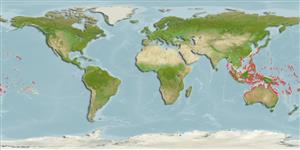Common names from other countries
>
Eupercaria/misc (Various families in series Eupercaria) >
Labridae (Wrasses) > Corinae
Etymology: Halichoeres: Greek, als, alis = salt + Greek, choiros = pig (Ref. 45335).
More on author: Valenciennes.
Environment: milieu / climate zone / depth range / distribution range
экология
морской ассоциированный с рифами; пределы глубины 0 - 5 m (Ref. 30874). Tropical; 32°N - 32°S, 91°E - 133°W
Indo-Pacific: Cocos Island in the eastern Indian Ocean to the Line and Tuamoto islands, north to southern Japan, south to New South Wales and Lord Howe Island. Replaced by Halichoeres nebulosus in the western Indian Ocean.
Size / Вес / Возраст
Maturity: Lm ? range ? - ? cm
Max length : 12.5 cm SL самец/пол неопределен; (Ref. 9823)
Краткое описание
определительные ключи | морфология | морфометрия
колючие лучи спинного плавника (общее число) : 9; членистые (мягкие) лучи спинного плавника (общее число) : 11; колючие лучи анального плавника: 3; членистые (мягкие) лучи анального плавника: 11. Females olivaceous on back, the scale edges dark brown, pale ventrally, with whitish blotches of unequal size and a large pink area posteriorly on the abdomen; a black spot on opercular flap, small one behind eye, one at front of dorsal fin and a large one rimmed in yellow or blue in middle of fin; no black spot at upper base of pectoral fins; males green with orange-red spots, some linked to form irregular markings, the white blotches and large pink area on abdomen lost, and the black spots lost or reduced. Males are distinguished by different cheek patterns. In this species, it has a near horizontal pink band below the eye (Ref. 48636).
Inhabits shallow reefs and rocky shores, usually in weedy areas exposed to surge (Ref. 9710, 48636). Feeds on benthic crustaceans, mollusks, polychaetes, forams, fishes, and fish eggs (Ref. 1602). One of several similar species that have near identical juvenile and female stages (Ref. 48636).
Life cycle and mating behavior
Maturities | размножение | Spawnings | Egg(s) | Fecundities | личинки
Distinct pairing during breeding (Ref. 205).
Randall, J.E., G.R. Allen and R.C. Steene, 1990. Fishes of the Great Barrier Reef and Coral Sea. University of Hawaii Press, Honolulu, Hawaii. 506 p. (Ref. 2334)
Статус Красного Списка МСОП (Ref. 130435)
CITES (Ref. 128078)
Not Evaluated
Угроза для людей
Harmless
Использование человеком
рыболовство: коммерческий; аквариум: коммерческий
дополнительная информация
инструменты
Специальные отчеты
Скачать в формате XML
ресурсы в Интернет
Estimates based on models
Preferred temperature (Ref.
115969): 24.7 - 29.1, mean 28.4 (based on 1912 cells).
Phylogenetic diversity index (Ref.
82804): PD
50 = 0.5000 [Uniqueness, from 0.5 = low to 2.0 = high].
Bayesian length-weight: a=0.00955 (0.00451 - 0.02020), b=3.09 (2.92 - 3.26), in cm Total Length, based on LWR estimates for this Genus-body shape (Ref.
93245).
Trophic level (Ref.
69278): 3.7 ±0.50 se; based on food items.
устойчивость к внешним воздействиям (Ref.
120179): высокий, минимальное время удвоения популяции до 15 месяцев (Preliminary K or Fecundity.).
Fishing Vulnerability (Ref.
59153): Low vulnerability (10 of 100).
